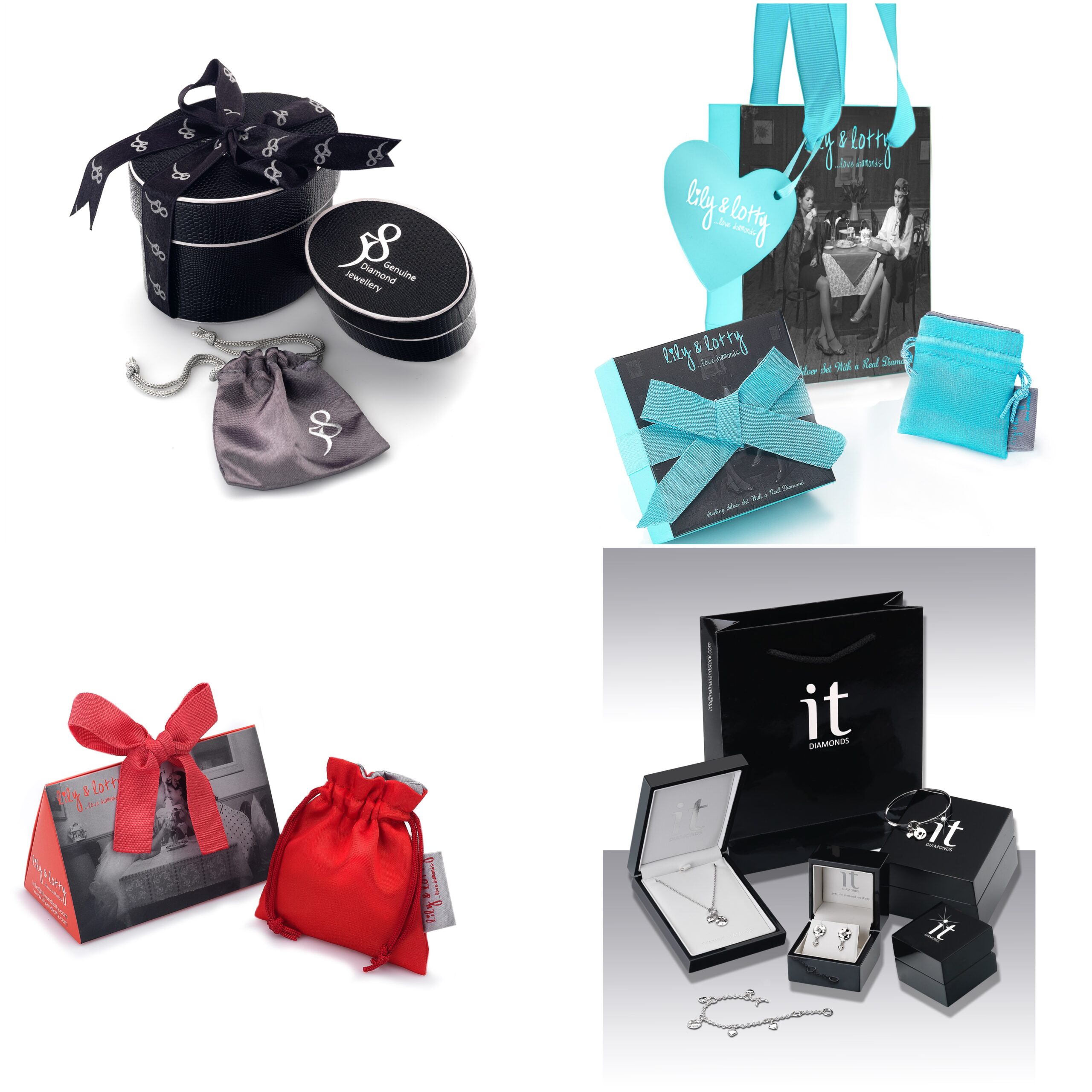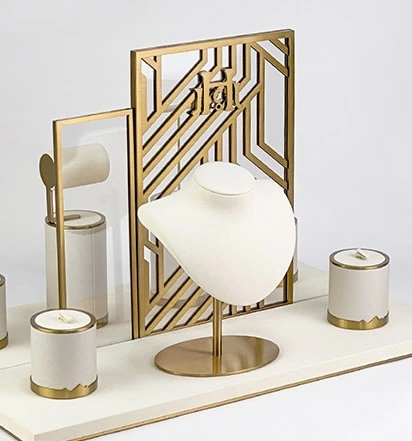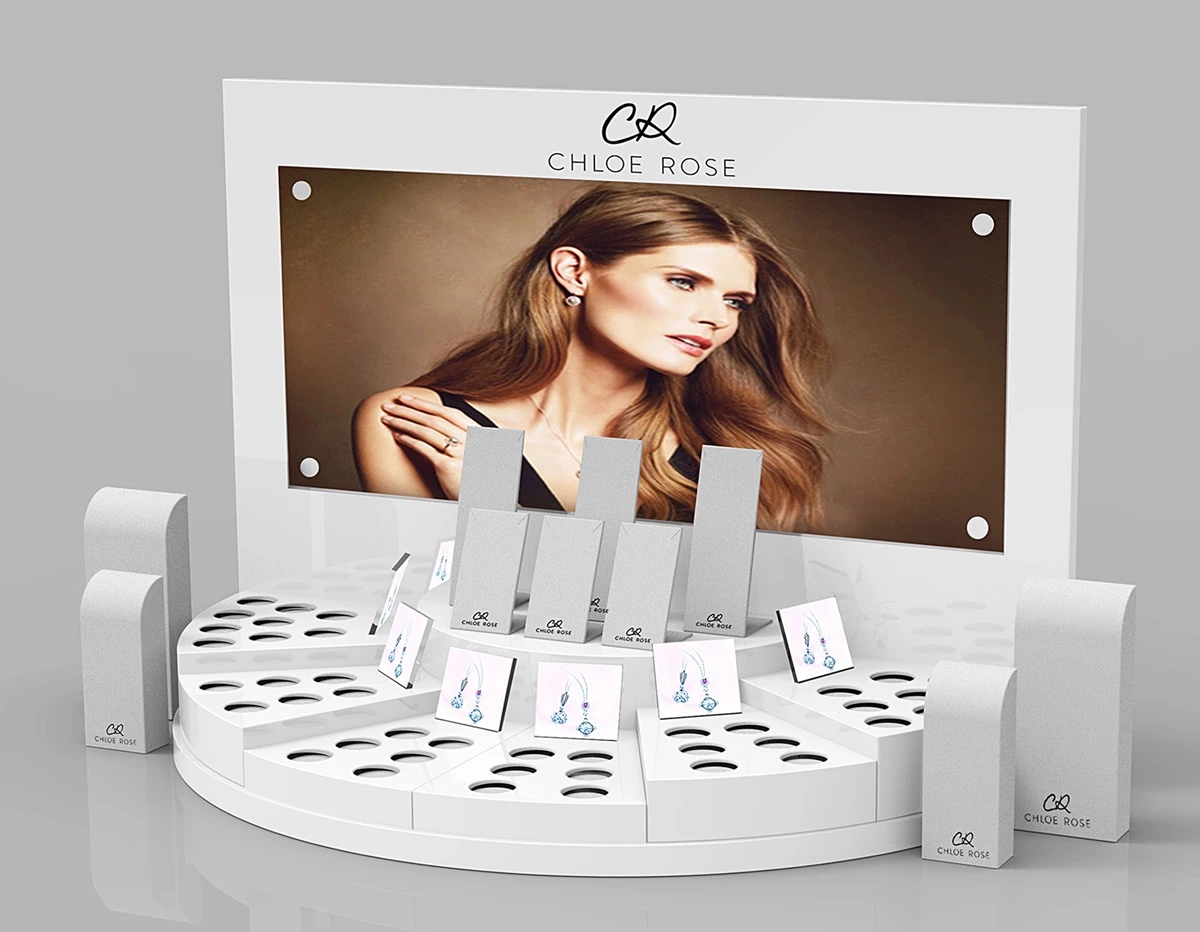Is your jewellery display truly captivating customers or merely blending into the background? In today’s competitive retail environment, the stakes for creating eye-catching jewellery displays have never been higher. Retailers must go beyond simple arrangement to craft experiences that allure and persuade. This guide unveils expert tips on designing high-impact custom jewellery displays that not only highlight your pieces but also enhance the overall shopping experience. By understanding the core principles of visual merchandising techniques and display aesthetics, retailers can transform their showcases into powerful tools for engaging and boosting sales.
Understanding the Basics of High-Impact Custom Jewellery Displays

Creating eye-catching jewellery displays is essential for attracting customers and increasing sales. A visually appealing display not only draws attention but also enhances the shopping experience by showcasing the jewellery’s allure and craftsmanship. Elements such as lighting, arrangement, and thematic coherence are vital in capturing and maintaining consumer interest, with the ultimate goal of prompting purchase decisions.
Jewellery merchandising techniques go beyond simple product placement. They involve crafting a narrative that resonates with potential buyers, encouraging them to engage with the pieces on display. This means utilising strategic groupings, such as by collection or theme, to tell a compelling story. Ensuring that each item is highlighted in a way that emphasises its unique qualities fosters a deeper connection with the customer, thus enhancing the overall shopping experience and driving sales.
The aesthetics of jewellery displays are critical in creating a high-impact presentation. A well-curated display should reflect the brand’s identity and appeal to the target demographic. Selecting materials and textures that complement the jewellery can elevate the display’s visual impact. Additionally, maintaining a balance between simplicity and sophistication ensures that the jewellery remains the focal point, increasing its desirability and perceived value.
Designing with Impact: Visual Merchandising Strategies for Jewellery
Storytelling in visual merchandising transforms jewellery displays into engaging narratives that captivate customers. By crafting a cohesive story, retailers can create an emotional connection with potential buyers, encouraging them to explore and engage with the pieces on display. Effective storytelling involves more than just arranging products; it’s about creating an environment that resonates with the shopper’s desires and aspirations. This can be achieved by thoughtfully curating collections that reflect a specific theme or journey, thereby enhancing the overall shopping experience and driving sales.
Reflecting Brand Identity
A jewellery display that successfully reflects brand identity strengthens customer loyalty and recognition. By using materials and styles that align with the brand’s image, retailers can convey a sense of sophistication and exclusivity. For instance, luxury brands might choose velvet or marble to underline their premium status. Such materials not only enhance the visual appeal of the display but also reinforce the brand’s core values and messaging. Ensuring that every element of the display is consistent with the brand identity helps in building a strong, memorable impression on customers.
Themed Groupings and Storytelling
Organising jewellery by theme or collection allows retailers to craft a cohesive story that draws customers in. Themed groupings can highlight the unique qualities of each piece while providing context that makes them more desirable. For example, arranging jewellery by colour, occasion, or fashion trend not only adds visual interest but also helps customers envision how the items fit into their lives. This strategic storytelling approach engages customers on a deeper level, encouraging exploration and increasing the likelihood of purchase. By creating a compelling narrative, retailers can enhance the allure of their displays, making them both memorable and effective.
The Role of Lighting in High-Impact Jewellery Displays
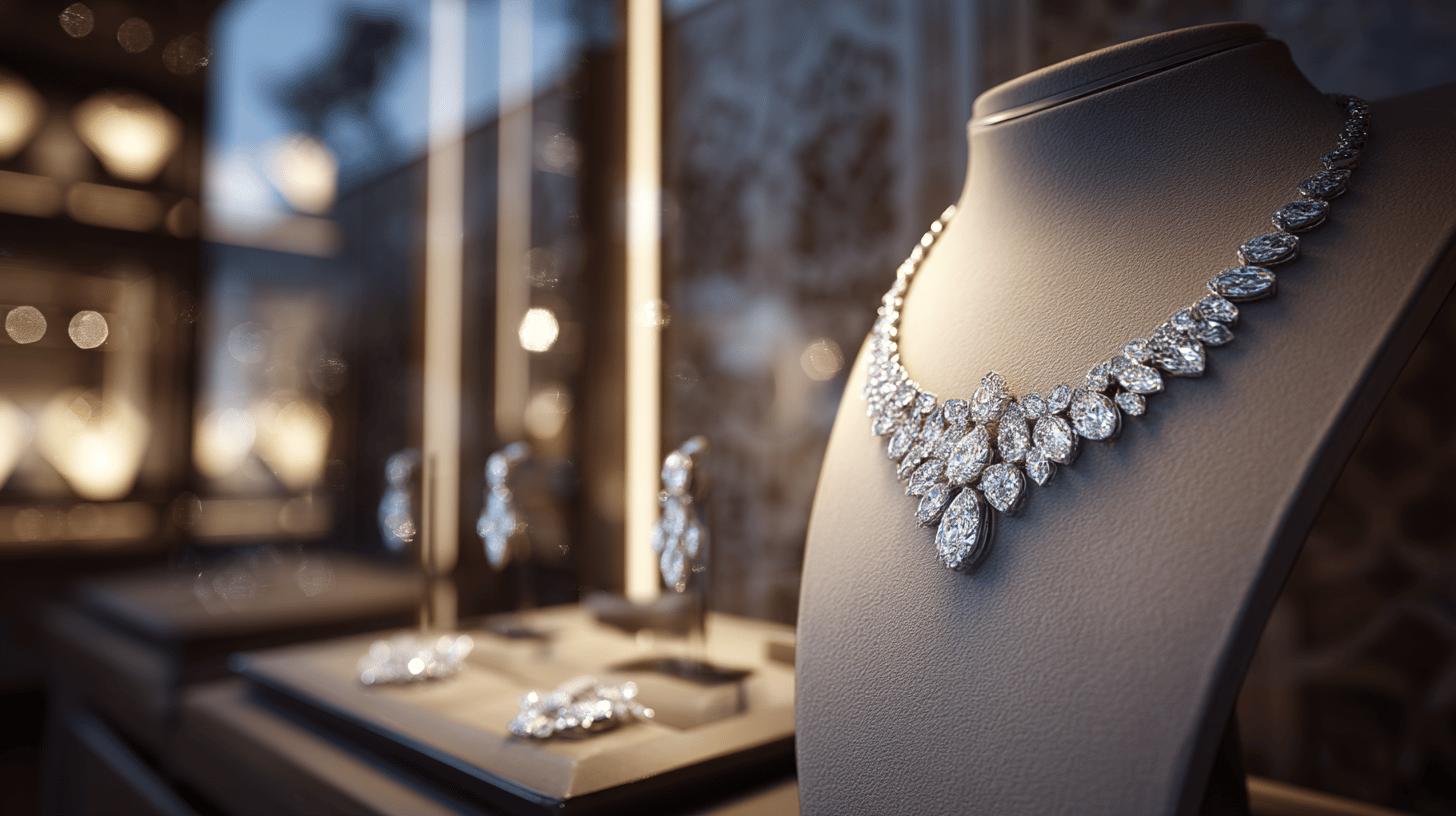
Lighting plays a crucial role in elevating the visual appeal of jewellery displays, drawing customer attention and highlighting the intricate details of each piece. How does lighting enhance jewellery displays? Lighting accentuates the brilliance and craftsmanship of jewellery, making it more enticing to potential buyers. By directing light strategically, retailers can enhance the sparkle and colour of gemstones, creating an inviting and luxurious shopping environment. Proper lighting also helps in setting the mood and atmosphere of the display, contributing to the overall brand image and consumer experience. In window displays, lighting is pivotal as it not only attracts foot traffic but also influences consumer perceptions and purchasing decisions.
- LED spotlights
- Track lighting
- Backlighting
- Adjustable display lamps
- Energy-efficient lighting solutions
Adapting lighting strategies to suit different seasons and sustainability requirements is essential for maintaining an effective jewellery display. How should retailers adjust their lighting for seasonal changes and sustainability? By using energy-efficient lighting solutions, retailers can reduce their environmental impact while maintaining the vibrancy of their displays. During darker months, retailers might increase the use of warmer lighting to create a cosy and inviting atmosphere, whereas cooler lighting can be more effective during brighter seasons. Additionally, incorporating adjustable display lamps allows for flexibility in directing light as needed, ensuring that each piece is showcased to its full potential regardless of seasonal variations. Consideration of sustainability in lighting choices not only aligns with modern consumer values but also enhances brand reputation.
Selecting Materials and Accessories for Custom Jewellery Displays
Material selection is fundamental to communicating brand identity and elevating the aesthetic appeal of jewellery displays. How does material choice reflect brand identity? By selecting materials such as velvet and marble, luxury brands convey sophistication and exclusivity. These materials not only enhance the visual appeal but also create a tactile experience that aligns with the brand’s image. Textures and finishes add dimension to displays, making them more visually engaging and memorable. As sustainability becomes a priority, brands are increasingly opting for eco-friendly materials, ensuring that their displays resonate with environmentally conscious consumers while maintaining their luxurious appeal.
Accessories play a crucial role in enhancing the functionality and visual allure of jewellery displays. What role do accessories have in jewellery displays? They facilitate organisation and add flair, ensuring that each piece is presented optimally. Accessories such as display stands, risers, and trays help in structuring the layout, allowing for better visibility and accessibility of the jewellery. By incorporating elements like mirrored surfaces or lighting accents, retailers can further amplify the display’s impact. Thoughtful selection of accessories not only complements the primary materials used but also enhances the overall shopping experience by making the displays more dynamic and engaging.
Maximising Space and Layout for Engaging Custom Jewellery Displays
Efficient use of space is crucial in designing jewellery displays that attract customers and encourage interaction. Why is efficient space use important in retail environments? It ensures a functional and inviting shopping atmosphere, ultimately enhancing the customer experience and driving sales. By strategically utilising available areas, such as empty walls and corners, retailers can create visually appealing displays without overwhelming the space. This approach not only maximises the store’s potential but also guides customers through a curated journey, highlighting different collections and promoting exploration.
Innovative Layout Techniques
How can retailers make the most of small spaces? By employing innovative layout techniques like vertical space utilisation, corner displays, and rotating units. Vertical displays draw the eye upward, making efficient use of available height and freeing up floor space for other elements. Corner displays transform underutilised areas into focal points, encouraging customers to explore every part of the store. Rotating units are particularly effective in small spaces, allowing customers to view multiple items without disrupting the overall layout. These techniques, when combined, create a dynamic and engaging environment that caters to both aesthetic appeal and functional needs.
Rotating and modular displays play a pivotal role in maximising space and enhancing customer engagement. How do these displays benefit retail environments? They offer flexibility and adaptability, enabling retailers to easily update and rearrange displays based on changing inventory and trends. Modular designs allow for customised configurations that can be adjusted to suit different collections or promotional campaigns. Rotating displays, in particular, provide an interactive element, encouraging customers to engage directly with the products. By incorporating these versatile display solutions, retailers can maintain a fresh and captivating shopping experience, encouraging repeat visits and fostering brand loyalty.
Incorporating Technology and Interactive Elements in Jewellery Displays
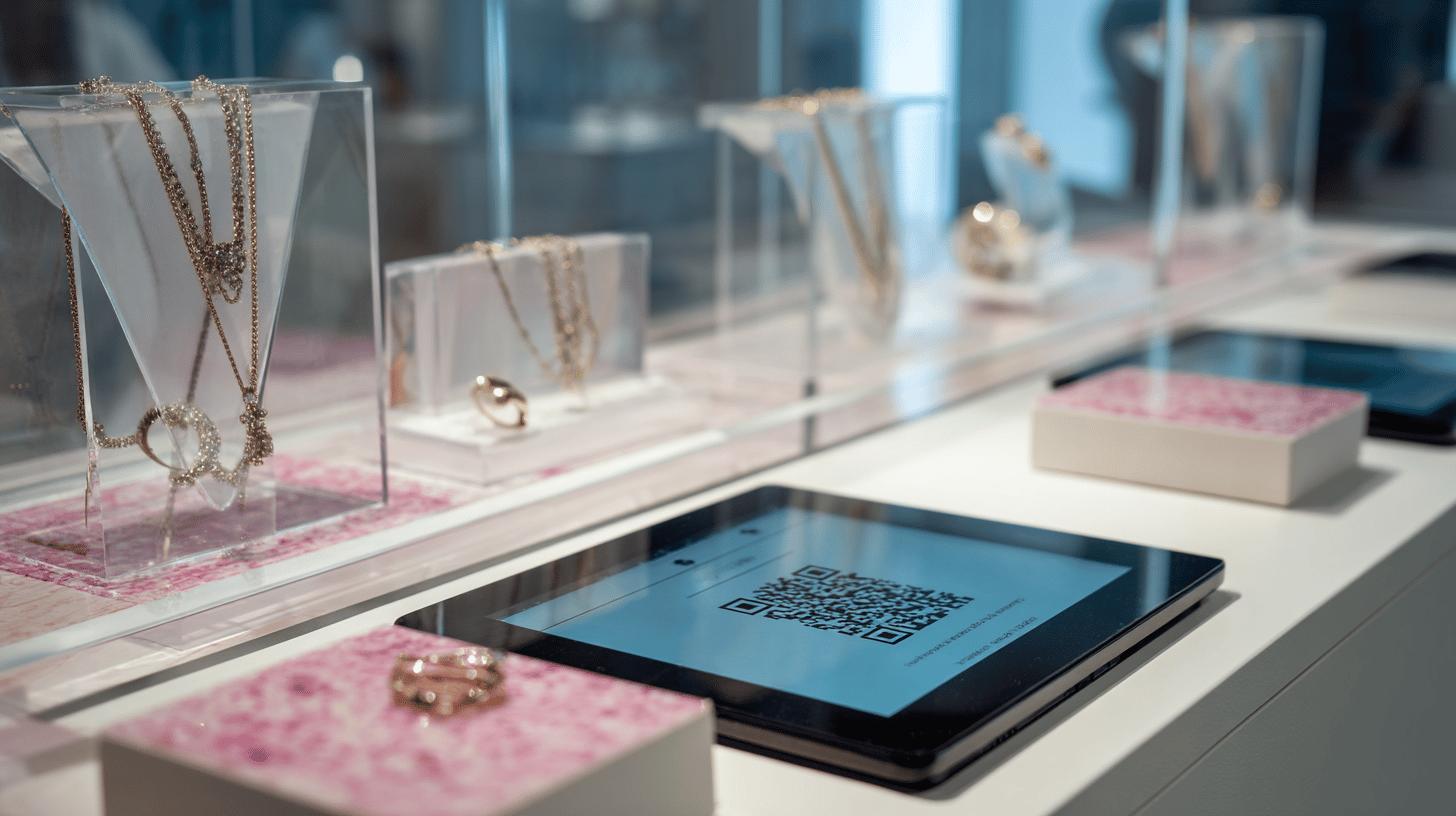
How do QR codes and augmented reality enhance jewellery displays? By providing interactive and engaging experiences, these digital elements captivate tech-savvy consumers and offer an omnichannel experience. QR codes allow customers to effortlessly access detailed product information, reviews, and styling tips through their smartphones, enriching their in-store shopping journey. Augmented reality enables shoppers to virtually try on jewellery, visualising pieces in real-time without physical contact, thus enhancing confidence in their purchase decisions. These technologies not only streamline the shopping process but also create a seamless integration between physical and digital retail environments, making the experience more engaging and informative.
How can these technologies create an interactive and memorable shopping experience? By offering dynamic and personalised interactions, they transform traditional displays into immersive experiences that resonate with modern consumers. Interactive displays equipped with touchscreens or tablets invite customers to explore collections, customise jewellery pieces, or learn about craftsmanship in an engaging manner. Such elements encourage deeper engagement, fostering a memorable shopping experience that distinguishes the retailer from competitors. By investing in these technologies, retailers can enhance customer satisfaction and loyalty, ultimately driving sales and reinforcing brand identity.
Case Studies: Successful High-Impact Jewellery Displays
Examining successful jewellery displays provides valuable insights into the creative and innovative approaches that lead to enhanced customer engagement and sales. These real-world examples offer retailers inspiration and strategies that can be adapted to suit their unique brand identities and store environments. By understanding what makes these displays effective, retailers can implement similar techniques to captivate their target audience, ultimately driving foot traffic and increasing conversions.
One notable case study involves a high-end jeweller who transformed their showroom design with bespoke display solutions. The retailer utilised a combination of custom-designed stands and strategic lighting to create a luxurious ambience that resonated with their clientele. Each display stand was crafted to reflect the brand’s sophisticated image, using materials such as brushed metal and glass, which not only enhanced the visual appeal but also provided a cohesive look across the showroom. By incorporating interactive elements, such as touchscreens that allowed customers to learn more about the jewellery’s craftsmanship, the retailer created an engaging and informative shopping experience that set them apart from competitors.
- Utilising bespoke designs to reflect brand identity
- Incorporating innovative stand designs for visual interest
- Crafting immersive environments through strategic layout and lighting
Retailers are encouraged to creatively adapt these ideas to fit their own brand ethos and retail spaces. By focusing on bespoke jewellery display designs that align with their image, and incorporating innovative jewellery stand designs, retailers can craft high-impact showroom displays that not only attract attention but also foster an immersive shopping experience. The key lies in combining aesthetic appeal with functionality, ensuring that each display element contributes to a cohesive and engaging environment that encourages customers to explore and invest in the jewellery pieces on offer.
Final Words
Designing high-impact custom jewellery displays is integral to retail success.
Key elements—material selection, the use of lighting, and strategic merchandising—work together
to elevate both brand appeal and customer engagement. Incorporating technology and adapting layouts
for small spaces further enhances the shopping experience.
By leveraging innovative strategies, retailers create compelling visual stories that resonate with consumers.
Ultimately, achieving a harmonious balance between aesthetics and function can transform
displays into powerful brand ambassadors, encouraging increased footfall and sales.
Embracing these techniques allows for continual evolution and creativity in an ever-competitive market.
FAQ
What are the fundamentals of creating eye-catching jewellery displays?
Effective jewellery displays should focus on attracting and engaging customers. High-impact displays not only improve the shopping experience but also boost sales through compelling visual merchandising and creating a memorable retail environment.
How do visual merchandising techniques enhance jewellery sales?
Visual merchandising enhances sales by crafting an experience that persuades shoppers to act. Displays should highlight jewellery features while integrating storytelling and brand identity for a cohesive and compelling presentation.
What role do aesthetics play in crafting impactful jewellery displays?
Aesthetics are crucial in jewellery displays as they draw customers in and encourage browsing. A well-thought-out design should balance colour, texture, and materials to maintain visual interest and align with brand identity.
How can a brand identity be reflected in jewellery display design?
Jewellery displays reflect brand identity through strategic use of materials and design elements. Luxury brands, for instance, opt for high-quality materials like velvet and marble to convey sophistication and align with their brand image.
What are the benefits of themed groupings in jewellery displays?
Themed groupings benefit displays by creating cohesion and telling a story, which attracts and engages customers. Grouping by collection or theme offers a visually appealing and structured approach that resonates with shoppers.
Why is lighting essential in jewellery displays?
Lighting enhances the visual appeal of jewellery displays by highlighting features and drawing attention. Effective lighting techniques need to adapt to seasonal changes and ensure energy efficiency, ultimately elevating the customer’s shopping experience.
What materials are recommended for jewellery displays?
Jewellery displays should use materials that reflect the brand’s identity, with considerations for sustainability. Common materials include velvet, glass, and marble, enhancing sophistication and visual appeal while supporting sustainable practices.
How can space be maximised in jewellery displays?
Maximising space involves utilising empty walls and corners, employing rotating displays, and employing modular units. These strategies ensure efficient use of space while maintaining a functional and inviting retail environment.
What role does technology play in modern jewellery displays?
Technology plays a pivotal role by integrating digital elements such as QR codes and augmented reality, enhancing interactivity and creating an engaging shopping experience that appeals to tech-savvy consumers.
How can case studies of successful jewellery displays inspire retailers?
Examining successful jewellery displays offers retail inspiration and innovative ideas. These case studies, with bespoke designs and immersive layouts, provide real-world examples that retailers can creatively adapt to their own contexts.




